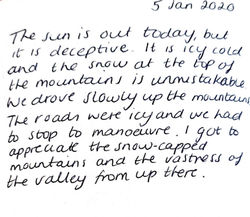Birdsong and Sound
Audiovisual collage by Catherine Finn
Ireland's musical and storytelling traditions are strongly linked, with sound and speech often used interchangeably in performance. Music in Glenasmole is in constant harmony with the sounds of the landscape. This is an exploration of those sounds. Featured in this audiovisual piece is my arrangement of 'Gleann na Smól', a jig that I learned to play on violin by ear and by memory. The process of learning the jig was as much an act of imagination as memorisation. I might have forgotten some notes and phrases here and there, but the more I played, the more harmonies and expressions I found through improvisation.
Landscape, Myth and Memory
The stories of Ireland are interwoven into expansive and enchanting landscapes. The valley of Glenasmole possesses a wealth of ancient knowledge and folktale within its hills. The valley's stories span across time as well as land, and linger on in the lives of its residents.
Touch the red dots to discover more about Glenasmole.
Glenasmole is a valley that lies within the Dublin Mountains and is situated just beyond the urban suburbs of Tallaght. It is home to a close-knit rural community and a landscape which seems like a distant world in comparison with the nearby city.
The area derives its name from the Irish, 'Gleann na Smól,' meaning Valley of the Thrushes. Like many Irish placenames, this descriptive name leads one to wonder about what sounds and stories are contained within the valley. Manchan Magan explores the the worlds behind Irish words in Thirty-Two Words for Field :
'The richness of a language closely tied to the landscape offered our ancestors a more magical way of seeing the world.'
The placename Gleann na Smól highlights that sound is an important presence in the valley, and that its residents experience the valley through strong audiovisual associations.
Click on the bird for an exploration of sound and music in the valley!
Pat Lee
The Field Names of Glenasmole (2015)
"Field names are an important repository of folk memory and a window to the past. They remain in use today in the day to day activties of local farmers – helping to pinpoint the location of livestock in the hills or simply by confirming the 'sense of place' that connects local people inextricably to their own home place."

Land on Paper
Click once to drag. Click twice for captions.
 |  |  |
|---|---|---|
 |  |  |

Hauntological Landscape

Audiovisual collage by Catherine Finn
"the eerie"
is constituded by a failure of absence or by a failure of presence. The senseation of the eerie occurs either when there is something present where there should be nothing, or there is nothing present when there should be something."
Mark Fisher, The Weird and the Eerie (2016, 62)


Catherine Finn
Glenasmole bears the memories of its rich past not only through stories but through the remnants and ruins of distant times. Ancient graveyards, burial stones and mythological site mark a vast and often empty landscape with gateways into other worlds. These point towards an absence of past communities that once populated the valley. The people of Glenasmole navigate a collage of time periods and eerie space, while encountering portals in the landscape which invite them to imagine people and stories lost in time.
Catherine Finn


Catherine Finn


Charles Russell, 1881

Charles Russell, 1881

Catherine Finn

Caoimhín O'Danachair, 1935

Catherine Finn




Catherine Finn
Source: Bohernabreena: A Walk in Time (1991)
Catherine Finn
Fisher contributes the sensation of the eerie to an agency that lies behind unusual presence or absence. In Glenasmole, the agency of time is omnipresent across the landscape and in the community's experience of it. The physical affects of time can be seen in the deterioration of local statues, the rusting of old gates and the erosion of carved messages into rock:
A mythical stone lifted by Fionn MacCumhaill is no longer identifiable due to the erosion of information which was once displayed on its surface. This opens up gaps in knowledge about the myth and the stone's significance.

Erosion of Fionn MacCumhaill's stone
Catherine Finn
the agency of time


Catherine Finn
"Gaps and inconsistencies are constitutive of what we are. What covers over these lacunae are stories – which therefore possess their own agency. Memory is already a story, and when there are gaps in memory, new stories must be confabulated to fill in the holes."
Mark Fisher, The Weird and the Eerie, (2016, 72)
st. anne's well
Glenasmole locals report that St. Anne's Well has wondrous healing properties. Once a year, the community gathers at the well to pray in the hopes of being by cured by the well. Some say the well heals sick stomachs, others say it cures sore eyes.




This sign points out that St Anne is a 'miscalled' name for what is actually Kilnasantan, Yet both locals and outsiders continue to call it by the name they are familiar with.
Catherine Finn
Catherine Finn
Catherine Finn
Catherine Finn
Time has deepened the holes in knowledge of Glenasmole's history and foggy distinctions between myth and fact. These histories are not only obscured time's physical effects on the land, but through its effect on the people's memories. It was in the oral tradition that much of the valley's local history was stored. Naturally, details have been forgotten or changed over time. When presented with failure of memory, people turn to the imagination in order to complete their understanding and belief in knowledge. The people navigate gaps in knowledge as they travel through the landscape and recall their community's history. In Glenasmole, identity, landscape and reality are constructed through the complex blending of local memory and imagination.